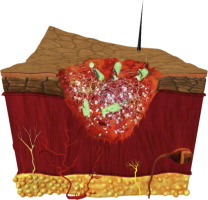Advanced Drug Delivery Reviews ( IF 15.2 ) Pub Date : 2017-08-04 , DOI: 10.1016/j.addr.2017.08.001 Mirza Ali Mofazzal Jahromi 1 , Parham Sahandi Zangabad 2 , Seyed Masoud Moosavi Basri 3 , Keyvan Sahandi Zangabad 4 , Ameneh Ghamarypour 5 , Amir R Aref 6 , Mahdi Karimi 7 , Michael R Hamblin 8

|
According to the latest report from the World Health Organization, an estimated 265,000 deaths still occur every year as a direct result of burn injuries. A widespread range of these deaths induced by burn wound happens in low- and middle-income countries, where survivors face a lifetime of morbidity. Most of the deaths occur due to infections when a high percentage of the external regions of the body area is affected. Microbial nutrient availability, skin barrier disruption, and vascular supply destruction in burn injuries as well as systemic immunosuppression are important parameters that cause burns to be susceptible to infections. Topical antimicrobials and dressings are generally employed to inhibit burn infections followed by a burn wound therapy, because systemic antibiotics have problems in reaching the infected site, coupled with increasing microbial drug resistance. Nanotechnology has provided a range of molecular designed nanostructures (NS) that can be used in both therapeutic and diagnostic applications in burns. These NSs can be divided into organic and non-organic (such as polymeric nanoparticles (NPs) and silver NPs, respectively), and many have been designed to display multifunctional activity. The present review covers the physiology of skin, burn classification, burn wound pathogenesis, animal models of burn wound infection, and various topical therapeutic approaches designed to combat infection and stimulate healing. These include biological based approaches (e.g. immune-based antimicrobial molecules, therapeutic microorganisms, antimicrobial agents, etc.), antimicrobial photo- and ultrasound-therapy, as well as nanotechnology-based wound healing approaches as a revolutionizing area. Thus, we focus on organic and non-organic NSs designed to deliver growth factors to burned skin, and scaffolds, dressings, etc. for exogenous stem cells to aid skin regeneration. Eventually, recent breakthroughs and technologies with substantial potentials in tissue regeneration and skin wound therapy (that are as the basis of burn wound therapies) are briefly taken into consideration including 3D-printing, cell-imprinted substrates, nano-architectured surfaces, and novel gene-editing tools such as CRISPR-Cas.
中文翻译:

烧伤纳米医学和先进技术:预防感染并促进伤口愈合
根据世界卫生组织的最新报告,估计每年仍有 265,000 人因烧伤直接死亡。烧伤引起的死亡大多发生在低收入和中等收入国家,这些国家的幸存者面临终生的发病率。大多数死亡是由于感染引起的,当身体外部区域的大部分区域受到影响时。烧伤中微生物营养的利用、皮肤屏障的破坏、血管供应的破坏以及全身免疫抑制是导致烧伤容易感染的重要参数。通常采用局部抗菌药物和敷料来抑制烧伤感染,然后进行烧伤创面治疗,因为全身抗生素在到达感染部位方面存在问题,而且微生物耐药性不断增加。纳米技术提供了一系列分子设计的纳米结构(NS),可用于烧伤的治疗和诊断应用。这些纳米粒子可分为有机和无机(例如分别为聚合物纳米粒子(NP)和银纳米粒子),并且许多纳米粒子被设计为具有多功能活性。本综述涵盖皮肤生理学、烧伤分类、烧伤创面发病机制、烧伤创面感染的动物模型以及旨在对抗感染和刺激愈合的各种局部治疗方法。这些包括基于生物的方法(例如基于免疫的抗菌分子、治疗微生物、抗菌剂等)、抗菌光疗法和超声疗法,以及作为革命性领域的基于纳米技术的伤口愈合方法。因此,我们专注于有机和无机 NS,旨在将生长因子输送到烧伤的皮肤,以及用于外源干细胞的支架、敷料等,以帮助皮肤再生。最后,简要考虑了在组织再生和皮肤伤口治疗(作为烧伤伤口治疗的基础)方面具有巨大潜力的最新突破和技术,包括 3D 打印、细胞印迹基底、纳米结构表面和新型基因- 编辑工具,例如 CRISPR-Cas。











































 京公网安备 11010802027423号
京公网安备 11010802027423号